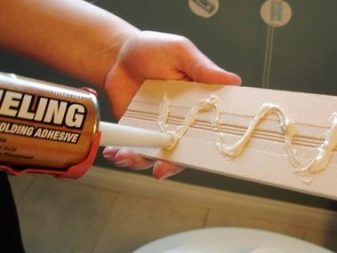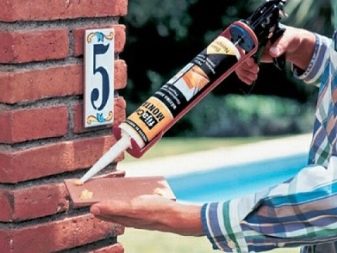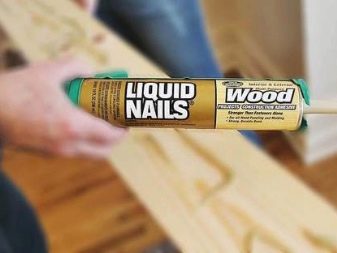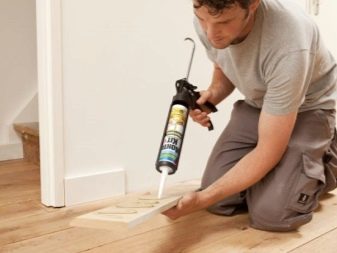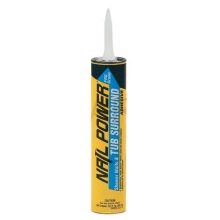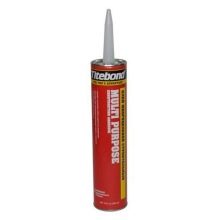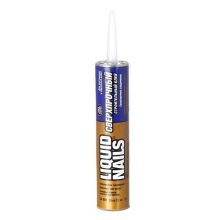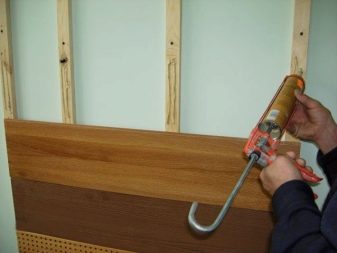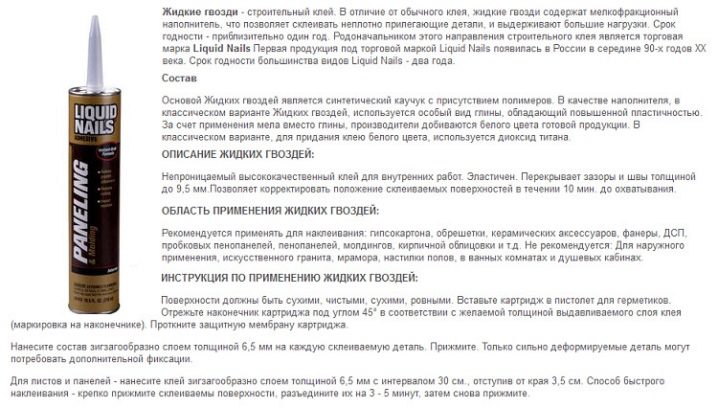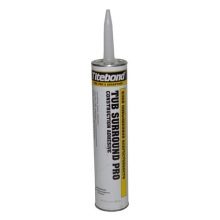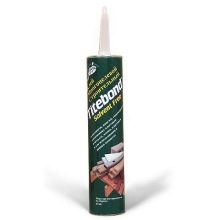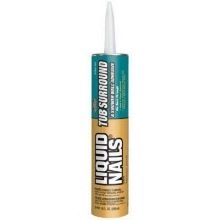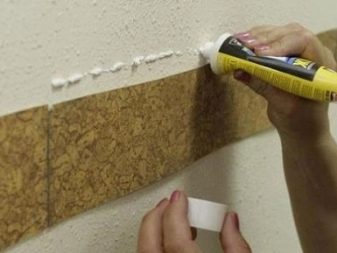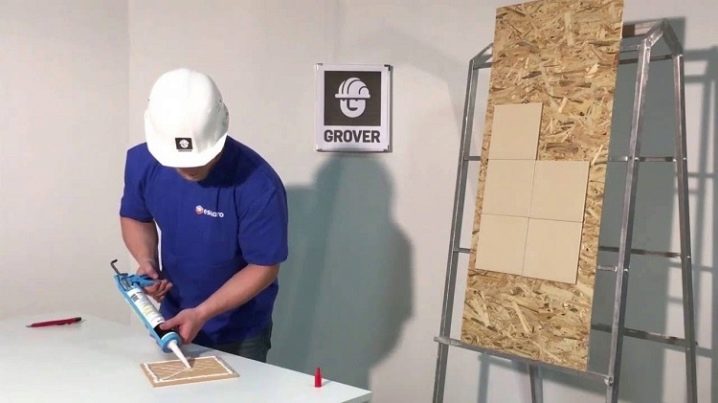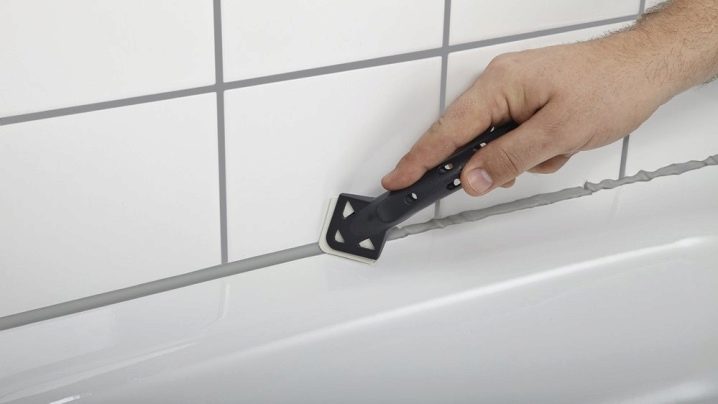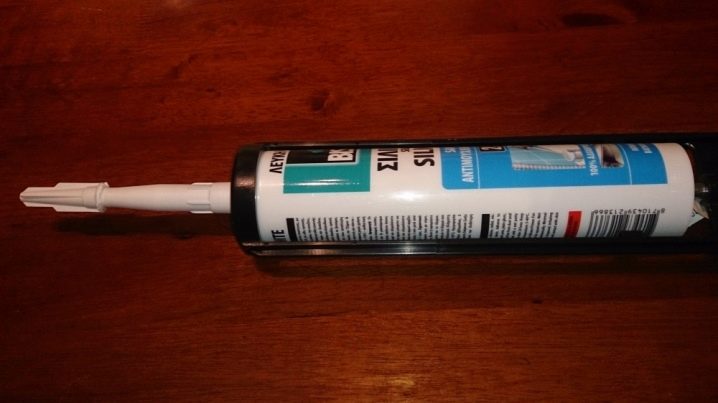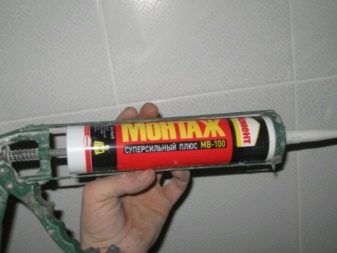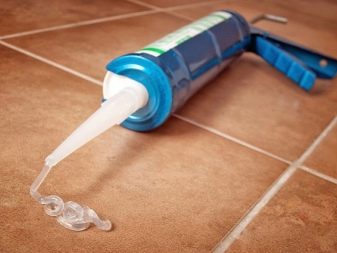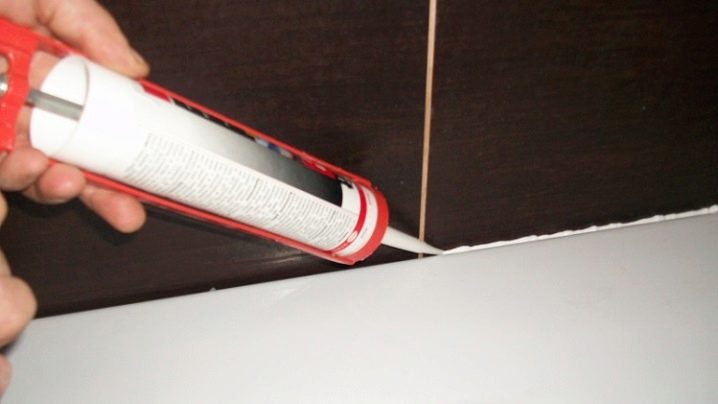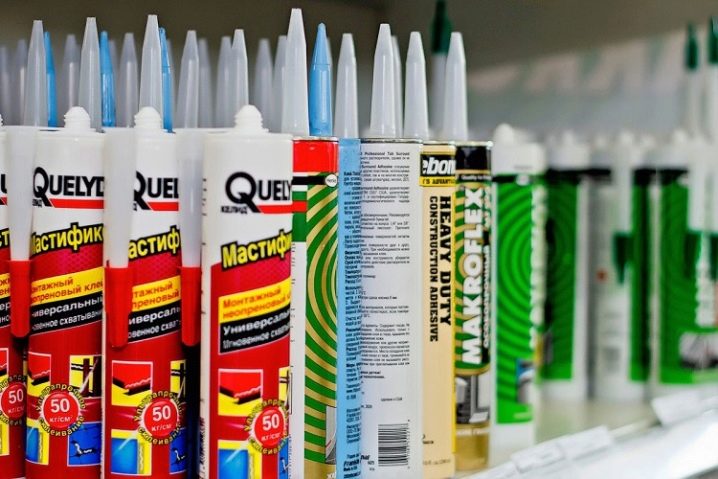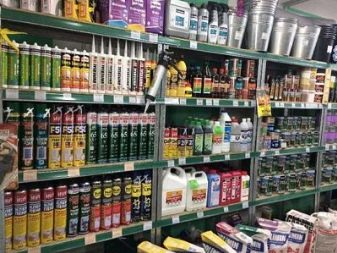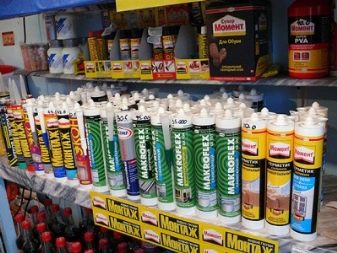Liquid nails for ceramic tiles: the pros and cons

When working with ceramic tiles use liquid nails. This material has a number of features, pros and cons: we understand together.
What is it?
Liquid nails - a modern adhesive composition, which is used to connect parts in construction. Joint strength is equivalent to nailing parts. This glue is packed in convenient for work packages in the form of tubes of various designs, which securely close for the period of inactivity. Otherwise, the glue may deteriorate. This is a reliable adhesion for most materials and surfaces, including ceramic tiles and gypsum base.
Drying and hardening time of the glue is much less, but it is enough to correct the errors in the installation.
Kinds
Modern liquid nails are presented in two main types:
- acrylic water emulsion;
- neoprene on organic solvents.
In terms of compound strength, these varieties are approximately equivalent., although there may be differences in quality and applicability. Acrylic-based liquid nails are diluted with water, which reduces the possibility of harmful effects on the body. You can use them in areas where there is no high humidity, and temperature drops are small. Otherwise, the adhesive base loses its properties.
If these conditions are met when working with porous materials and plastic, the connection is strong and durable.
The adhesive composition of liquid nails on organic solvents is heat-resistant. It is resistant to high humidity, reliably resists the action of the fungus. The setting time is short, there is almost no time to correct errors, so preparation for laying should be thorough. The strength of the glue is high, but ecologically liquid nails on a neoprene basis are more dangerous than acrylic analogues. During work and a few days after its completion, it is necessary to avoid being present in the room: harmful evaporation is not excluded. Both acrylic and neoprene glue are superior in strength to PVC glue.
How to choose?
The experience of the masters shows that it is more reliable to use water-soluble compositions Titan WB 50 or Solvent Free as liquid nails. For the bathroom, it is better to use another glue that is more resistant to such conditions, for example, “Power Pover” or “Teb Surround”. If you need to put massive, overall tiles, use Zigger 99, LN 901, Hevy Djuti. Excellent adhesion to brick, plasterboard, concrete and liquid nails Titebond Multi Purpos.
Working with ceramic tiles and liquid nails, it is necessary to carry out preparatory work very carefully. The end result depends on it. This glue is quite strong, but dusty, unprepared surface can cause poor adhesion.
The choice of glue matters: it must be chosen taking into account the weight of the material, its thickness, and the type of surface. It is important to take into account the type of plane (vertical, horizontal), the time for preliminary and final solidification. Before buying a total amount, you need to get advice from the masters or sellers on the choice of one or another glue, carefully study the instructions for several types of material.
Having defined the brand of glue, the estimated volume should be increased by 10-15%. This will avoid the shortage of liquid nails when working with tiles.
You can buy test samples and test them for suitability for the intended work.
It is worth considering the following:
- Check the glue setting time. The instructions indicate recommendations for proper use, including time.
- Chalk and calcium carbonate particles that reduce adhesion should be excluded.
- In the presence of acetone and toluene, the glue is not suitable for work, its smell and harmful effects can last for a long time.
- Some brands of water-soluble liquid nails (Solvent Free or Titan WB-50) can be used when sticking ceramic tiles in rooms with high humidity.
- Mirror amalgam will not deteriorate if liquid nails of the Moment Installation, LN-930 or Zigger 93 brands are used to fasten it.
- When working on the bathroom, you can use liquid nails brands "Tube Surround" or "Nail Power".
It is important to take into account one nuance: it takes about 12 to 24 hours to fully polymerize (solidify) all varieties.
Stages of work
Before glueing the surface of the tile it is necessary to clean, dry and degrease. Liquid nails are applied over the area with a thin snake, if the tiles are light, it is enough to apply them in dots.The tile must be pressed tightly against the prepared surface for a few seconds: this will determine the degree of strength. Liquid nails dry on the glued tile 24 hours, finally dry in a week. Touch and move the tiles in this period is not worth it, so as not to spoil the strength of fixation. After 5-7 days, proceed to grouting. It is not recommended to lay tiles on the floor of the bath using liquid nails: for such purposes use special waterproof glue.
Excess glue
In order to minimize the amount of surplus glue when sticking ceramic tiles, it is necessary to accurately determine its amount per tile. Experienced masters are able to do this; it is better to entrust such work to them in order to be confident in obtaining quick and high-quality results. However, in the course of work, the advantages of liquid nails can turn into disadvantages. For example, it is not always possible to remove dried glue: it is getting stronger every hour.
Therefore, it is advised to remove excess glue immediately during operation, using a clean, soft cloth for this.
If the moment is missed, it will be necessary to use more complex techniques to remove dried glue residues:
- Special cleaner that can be purchased at any building materials store. It is applied to areas with dried glue, incubated for 15-20 minutes, then washed off and wiped with a clean, soft cloth.
- You can use a scraper or brush-type attachments on the screwdriver. Here, too, some experience is needed in order not to damage the surface of the tiles.
- Remove small residues of adhesive with a cleaner. However, if the glue is taken tightly, this method is ineffective.
- You can heat the surface of the tile in any safe way to 60 degrees. When the glue has this temperature, it becomes soft and is removed with a spatula.
pros
Liquid nails have a lot of merit.
- They are waterproof: polymeric compounds have high resistance to water. The ingress of moisture into the seam does not affect the strength properties of the joint.
- Glue is distinguished by high strength: after curing, the composition becomes stronger than concrete and retains its properties for a long time.
- By voltage, the products of leading brands withstand up to 80 kg / sq. See. Liquid nails can fix ceramic tiles of considerable weight.
- They are characterized by resistance to rust, mold, fungus, rotting in conditions of high humidity.
- They are distinguished by automation: you can use a construction pistol for applying glue, this increases safety and production culture.
- This material is convenient: the composition is ready for use, there is no need to prepare a mixture.
- To correct errors there is a small time interval.
- Adhesive compositions of liquid nails are universal when gluing many homogeneous and heterogeneous surfaces, which is especially important when gluing tiles under the stone.
- The adhesion of this adhesive is high enough for most building and finishing materials.
Minuses
- Not all liquid nails are resistant to moisture. Increased humidity affects the main properties of the liquid nails of individual brands.
- Ceramic tiles are not recommended to be laid on the floor with the use of liquid nails, it is better to use a special tile adhesive. So it will be safer and cheaper.
- Varieties of glue on a neoprene basis can adversely affect the human body, so a rather long period is needed until the complete disappearance of neoprene fumes.
- Extra materials and time are required to remove excess cured adhesive.
- To fix the poor-quality installation after the beginning of the hardening of liquid nails almost fails.
- Work with liquid nails and ceramic tiles should be carried out under stable temperature conditions.
- When overheated in the cartridge glue loses its consistency and may become unsuitable for work.
The time during which the adjustment is possible is no more than minutes. This is enough for an experienced master, but for a beginner can be a real problem. All manufacturers produce liquid nails in cans of 300-500 grams, it is unprofitable with significant amounts of work.
If you lay tile over a large area, the cost of buying glue may exceed the cost of the lining itself.
The choice of adhesive formulations such as liquid nails is now wide., a careful approach will avoid mistakes and get a reliable result. Before starting work, you should try to find out more information about the quality of the glue and the possibilities of its use in specific conditions. Much information is contained in the instructions for use indicated on the product packaging. In general, liquid nails are glue with a good functional effect.The composition does not need to be specially prepared; with the help of a construction pistol, the composition is easily applied to the tile surface, sets in a short time and reliably holds glued parts of light weight.
When buying, it is worth paying attention to the expiration date: as it passes, the glue loses its properties, which can affect the quality of adhesion of the tile to the base of the surface.
For more information on this issue, you can learn from the video below.




